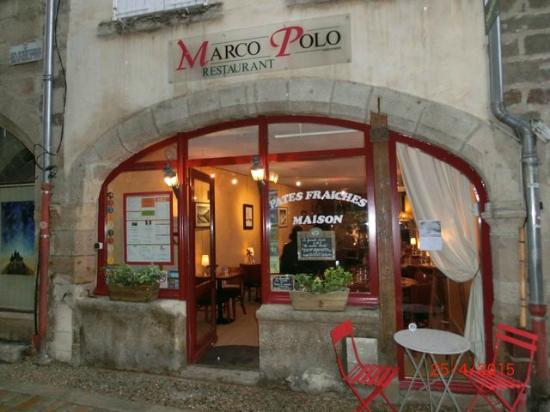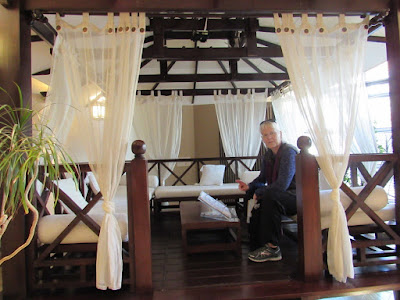The pilgrims gathered at Bambou & Basilic, a Michelin three-star restaurant in Le Puy, to celebrate their pilgrimage. The restaurant is in the old city, a 30-minute walk from the International Centre.
Angelique was our server, a patient and kind woman who afforded us excellent service and a friendly smile always. The food is described as fusion food that resides between the modernity and traditions of Le Puy. It was a real treat with insights into French cooking and service. Below, Angelique takes the count on who wants which meal: bamboo or basilic.
1. Amuse Bouche
 The "amuse bouche" course literally means the food that amuses your mouth. In other words, it is an appetizer or aperitif. It was served with champagne (some with a touch of chestnut or apricot flavoring) and some colorful and tasty morsels on tiny pieces of bread (left) or a bit of cold lentil soup (right).
The "amuse bouche" course literally means the food that amuses your mouth. In other words, it is an appetizer or aperitif. It was served with champagne (some with a touch of chestnut or apricot flavoring) and some colorful and tasty morsels on tiny pieces of bread (left) or a bit of cold lentil soup (right).
Angelique uncorks a bottle of delicious red wine from the Auvergne region. The chef takes special pride and care to serve local food.

2. Entrees
The entree is the first course of the meal. While Americans call the main dish their entree, the French call their entree the course that helps you "enter" the meal. We had a choice of four entrees.
Chicken with quail eggs and vegetables
Sot l’y laisse confit et œuf de caille sur un sablé aux herbes, concassée de tomates et tagliatelles de légumes
Fois gras of duck (liver)
Foie gras de canard « Maison », compotée de rhubarbe, dôme de pomme au Muscat de Rivesaltes, brioche toastée
Pumpkin soup
Velouté de potimarron de Saint Vincent, poudre de lard et amandes torréfiées

Shrimp with cucumbers, beets, goat cheese
Gambas marinées aux agrumes et curry, rouleau de concombre, vinaigrette aux perles du Japon et fromage de chèvre
Carol Crepeau, program director from La Grange, and Judy from Cleveland.


Kathy (left) from Wheeling with Mary (right) from Nazareth
3. Plat -- the main course
The main course or plat, is a meat, fish or vegetable dish in France. We had four choices.
Roasted Beef with onions and potato
Pièce de bœuf rôtie sur une compotée d’oignons rouge, râpée de pomme de terre, jus à l’échalote
Pollock fish
Lieu jaune rôti dans un beurre noisette, épinards et endives croquantes, mousseline de légumes et émulsion au citron confit
Gilt-head bream
Dorade royale sur une écume de Mona Lisa, brocolis et croustillant aux anchois, huile de chorizo
(This fish is a member of the bream family Sparidae found in the Mediterranean Sea and the eastern coastal regions of the North Atlantic Ocean.)
Lamb
Gigot d’agneau cuit à basse température, samossa d’épaule, jus corsé, condiment de poivrons aux piments de Cayenne
4. Cheese Course
Fresh cheese (before) with fruity syrup (after)
- Fromages affinés avec coulis

5. Dessert
Fruit and sorbet
Assiette de fruits frais de saisons et sorbets
Crunchy cookie with fruit and creme
Croustillant à la vergeoise, crémeux exotique, brunoise d’ananas et sorbet fruits rouges

Apple with cinnamon and beer ice cream
Déclinaison autour de la pomme, glace à la bière et crumble à la cannelle
Carol with Amandine, hostess of Bamboo & Basilic. She and her husband, Michaël, the chef, have owned the restaurant for the past five years. They have a two-year-old son.





























































